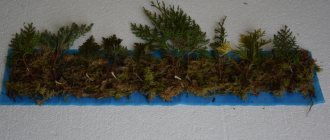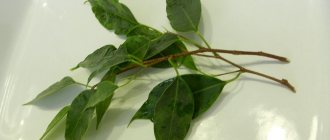What does ficus microcarpa look like, what family does it belong to?
Microcarpa belongs to the Mulberry family. The flower is remarkable for its bare trunk and root system. The roots are massive, rise up, twisting intricately.
Description of appearance:
- Height – from 2 to 3 m.
- The leaves are oval-shaped, curved at the end, located on short petioles. The foliage color is dark green, the length of the leaf blades is from 5 to 10 cm, the width is from 3 to 5 cm.
- The trunk is brown, covered with dense bark.
- The fruits are small yellow berries that, when fully ripe, acquire a burgundy hue.
Microcarpa is the king among ficuses
Additional Information! In nature, ficus reaches a height of 20 m. It is an epiphyte that grows on other trees.
Common varieties
The microcarp type includes the following varieties:
- Westland - length of leaf plates 11 cm, width - 5 cm.
- Green Gem is a variety with a very dense crown.
- Variegata - leaf blades are painted in variegated colors.
- Moklam - small leaf plates of dark green color, round in shape.
Ficus varieties were bred by specialists through long-term selection.
Medicinal properties
At home, ficus helps clean the air from carbon compounds - phenol, formaldehyde and benzene. The flower also has a positive effect on human energy. The tree improves overall well-being, reducing the incidence of viral and infectious diseases, normalizing the functioning of the central nervous system.
Briefly about the history of appearance
The homeland of ficus is Japan, the northern regions of Australia, and the southeastern regions of China. In Japan, ficus began to be used to create bonsai-style trees from the 6th century. There is no information about when and how it was introduced to Europe.
Based on microcarpas, you can create a real work of garden art
Microcarpa ficus - home care
Caring for the plant is easy. You just need to follow the standard rules for growing a flower.
Temperature
Ficus Kinki - description and care at home
Optimum temperature +25…+30 °C.
Attention! Not only the crown of the tree needs warmth, but also its root system. It is not recommended to place a ficus pot on the floor if it is cold, or on a windowsill.
Lighting
The plant does not like bright light or strong shadow. The ideal place is partial shade. It is recommended to place the container with ficus on the east or west side, slightly away from the window.
Watering
The tree should be watered as needed, allowing the top layer of soil to dry. Frequent and abundant watering can cause the root system to rot.
Spraying
The frequency of spraying depends on the temperature and humidity in the room. The drier the air, the more the plant needs moisture.
Humidity
The humidity level should be 60-70%.
Priming
For the flower, it is recommended to buy special soil intended for growing ficus or palm trees. You can make the soil yourself by mixing equal parts clay, picking soil and sand.
Ficus will be a great addition to any interior
Feeding
Fertilizers are used from May to October. It is recommended to use store-bought fertilizers for ficus plants. They are applied 2 times a month, adding to water for irrigation.
Features of care in winter, rest period
Ficus Robusta rubber - planting and care at home
Ficus dormancy begins in the second half of November and lasts until the end of April and the first days of May. The tree must be kept at room temperature. Phytolamps are used as additional lighting. Watering in winter is moderate. If the air is dry due to central heating, the plant is sprayed 1-2 times a week.
Attention! Do not allow the air in the room to cool to a temperature below +15 °C.
When and how does it bloom
Ficus pumila flower - description and care at home
Domestic ficus microcarpas bloom in the rarest of cases. The flowers are small, having no aesthetic value, collected from several inflorescences with a diameter of no more than 1 cm. The flowers are unusual, outwardly similar to berries - syconia.
Microcarpa has unusual flowers, like the tree itself
Flowering period and care at this time
Ficus blooms in July – September. At this time, you need to increase the frequency of watering and spraying, as well as regularly apply fertilizer.
Signs and superstitions
House ficus plants, including microcarp, are accompanied by interesting superstitions:
- the plant tidies up the energy at home, improving comfort;
- eliminates the negative atmosphere and energy with which ill-wishers and envious people could come to visit;
- Growing ficus in an office building improves the performance of employees.
Ficus microcarpa is a popular plant that even beginners can care for. These flowers grown from seeds deserve special attention. In the process of their development, interesting structures using the bonsai technique can be obtained from the root system.
How does Ficus Microcarpa reproduce?
Microcarpa is propagated by cuttings, seeds and air layering.
Germination of seeds
The seeds are pre-soaked in a growth stimulator. They are planted in nutritious soil consisting of sphagnum moss and peat.
The container with seeds is covered with plastic wrap. Provides diffused lighting and regular watering. As soon as the first shoots appear, the film is removed. The sprouts are planted in a permanent place so that the lower leaf plates are deepened into the ground.
Pruning is a mandatory measure for flower care.
Additional Information! It is very difficult to propagate ficus seeds, because... the probability of germination is low, and seedlings develop very slowly.
Rooting cuttings
Cuttings are the preferred method of propagating ficus. Procedure:
- The shoots are cut off. You need to choose strong, woody branches. They are cut into pieces up to 15 cm long, the cut is made at an angle.
- The lower leaf plates are removed.
- The cut is wiped of juice and treated with a growth stimulator.
- The shoots are planted in the ground and covered with film.
- They are watered regularly.
Instead of soil, the seed can be dipped in water with the addition of crushed activated carbon and the liquid can be changed periodically. Roots will begin to appear in about 6 weeks.
Air layering
Algorithm of actions:
- Step back 70 cm from the top of the branch, make 2 cuts at a distance of 4 cm.
- Insert matches into the sections to prevent the bark from accreting.
- Cover the cuts with damp sphagnum moss.
- Cover the area with film, making several punctures in it to allow oxygen to enter.
- Moisten the moss periodically using a syringe.
After 30-40 days, when the first roots appear through the moss, the film is removed. The branch is cut under the roots and planted in the ground.
Other options
The plant can also reproduce by root cuttings.
Attention! This procedure must be carried out before transplanting the flower. The branch needs to be trimmed, planted in the ground, and the container covered with film. Every day, the polyethylene must be removed for 30-40 minutes to allow the earth to breathe. As the soil dries out, it needs to be watered.
Rooting occurs in approximately 3-3.5 months. As soon as 3-4 leaf plates appear on the cutting, you can transplant it to a permanent place.
Reproduction methods
There are several ways to propagate ficus microcarpa. You can use seeds, cuttings or layering. The first method is used extremely rarely, since it is a very long process. Cuttings occur as follows:
- Separate the branches at an oblique angle, retreating from the nodes at a distance of 1 cm.
- Place the cuttings in warm water, pour it into a container that will not be transparent.
- After a day, drain the liquid and place the cuttings in fresh liquid, to which add a small amount of ash.
- After the roots appear, transplant the sprouts into pots with soil and cover with film material.
- After the young leaves appear, remove the covering film.
You can plant cuttings directly into the soil, immersing each plant 3-5 cm in the soil
It is important to control humidity and spray plant stems. Rooting using this method occurs within 30 days.
Ficus propagation can be done using seeds; it is better to buy them in special stores. The planting process is not complicated, but growing a full-fledged plant takes a long period of time. To propagate ficus using seeds, you must:
- Soak the seed in a liquid containing a growth stimulator.
- Plant in boxes, keeping a distance of 2 cm from one another.
- You need to use light and airy soil that has a high sand content.
- When the seeds are planted, the soil is sprayed using a spray bottle. The boxes are covered with film material, glass can be used.
It is important to ensure that the soil is always moist. Every day, the covering material should be removed for some time so that the soil and sprouts have the opportunity to breathe fresh air, as well as to evaporate excess moisture
After the first leaf appears, each sprout is cut into a separate container.
Transfer
The sequence of actions when planting a ficus in a new container:
- Water the flower generously.
- Carefully remove it from the old flowerpot.
- Place expanded clay for drainage and a layer of sand in a new pot.
- Place the ficus in the container, fill the voids with soil and tamp down a little.
The ficus container should be wide and shallow
Beneficial features
Ficus, like all plants, produces large amounts of oxygen . The flower is able to absorb harmful substances - benzene, phenol, formaldehyde. This ability is especially relevant for people living in large cities with developed heavy industry.
It is believed that ficus in the house is able to improve family relationships, bring harmony and love. The plant attracts prosperity and good luck.
Possible problems during cultivation and diseases
Caring for microcarpa is not difficult, but some difficulties may arise when growing ficus:
- The flower sheds buds and leaves. This is a sign of a lack of minerals. The plant needs to be fed and provided with abundant, diffused lighting.
- The leaves are turning pale. This happens when there is insufficient lighting.
- The tips of the leaves dry out. This is how the plant reports a lack of moisture or an excessive amount of it, or a lack of fertilizer.
- The lower leaves fall off. This is a sign of rotting of the root system.
Pests
Aphids, mealybugs or scale insects may appear on the ficus. To get rid of insects, the plant must be placed under the shower, after covering the ground with a film, and then treated with insecticides.
Other problems
The following problems may occur due to improper care:
- The appearance of gray spots on the leaf blades indicates stagnation of water and rotting of the root system.
- The curling of the plates occurs due to sunburn.
To restore the plant, you need to remove the damaged parts and adjust its care.
Views from photos
Ficus microcarpa combines several subspecies:
- ginseng or ginseng;
- dull;
- small-fruited;
- ficus microcarpa Pur Gold;
- Ficus microcarpa Moclaim;
- ficus moklame.
The varieties have minor differences from each other. Plants vary in trunk thickness, leaf size, and shade.











